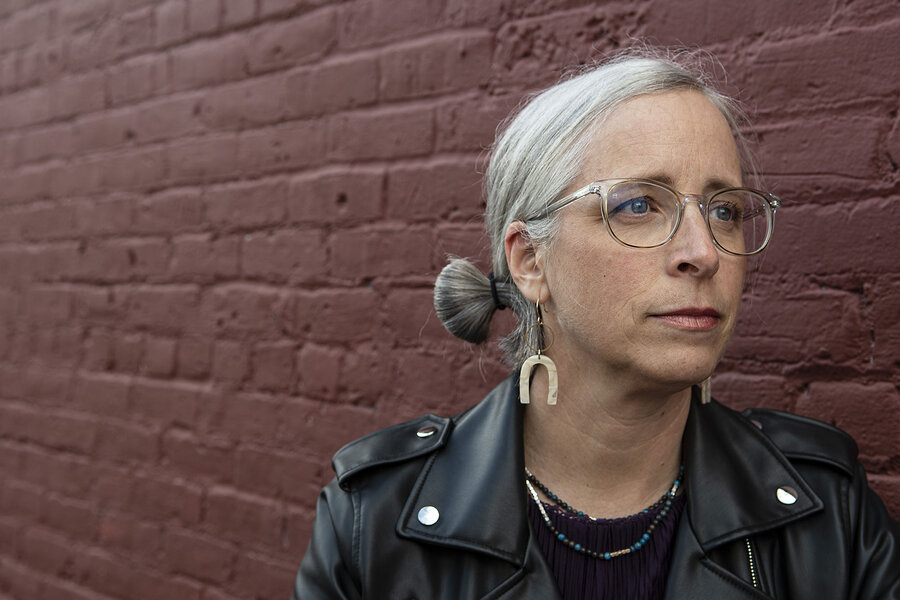Singer Laura Veirs finds creativity everywhere – bikes, skates, power saws
Loading...
| Portland, Ore.
Musician Laura Veirs is constantly reinventing herself.
This month, she released her first live album, “Laura Veirs and Her Band (Live in Brooklyn).” It’s self-produced. She has recently embraced other firsts, such as adopting a dog, learning to dance, and practicing French on a language app. Those activities replenish the groundwaters of her creative wellspring, often finding fresh channels for artistic expression.
Why We Wrote This
A story focused onFor some artists, inspiration comes when ideas flow naturally, rather than being demanded. With the release of her latest album, songwriter Laura Veirs reflects on how creativity manifests itself.
Ms. Veirs released her eponymously titled debut 25 years ago. Twelve more solo albums have followed. She’s been running her own cottage industry, Raven Marching Band Records, while raising two kids. That led to a podcast, “Midnight Lightning,” in which she interviewed other mothers about balancing music careers with having children.
“I just go with the flow of where my life is instead of being like, ‘Well, you’re a songwriter, so you have to sit here and grind at this for eight hours a day for the rest of your life, because that’s all you get to do!’”
She pauses to laugh, then adds, “That’s not how I see creativity.”
For Laura Veirs, cycling was a time for crying.
It was 2018. Few would have suspected that the songwriter’s life was unraveling. Two years earlier, a supergroup collaboration with Neko Case and k.d. lang had elevated her profile. Her latest solo album, “The Lookout,” had wowed critics. It exemplified her talent for creating lyrical images of nature, like a plein-air painter utilizing a folk-rock palette. One song included her two young children on backing vocals. The title track was a tribute to her music producer husband.
She hadn’t anticipated her marriage would end.
Why We Wrote This
A story focused onFor some artists, inspiration comes when ideas flow naturally, rather than being demanded. With the release of her latest album, songwriter Laura Veirs reflects on how creativity manifests itself.
At the time, Ms. Veirs found out that two friends were preparing for a 100-mile bike ride. A query: Could she join them? She bought a bike and started training. That’s when she’d release pent-up tears.
“Biking is the main thing that helped me process my divorce,” says Ms. Veirs, hands cradling a hot drink outside a coffee shop near her Portland, Oregon, home.
It also heralded a fresh life cycle. The songwriter is constantly reinventing herself. This month, Ms. Veirs released her first live album, “Laura Veirs and Her Band (Live in Brooklyn).” It’s self-produced. She has embraced other firsts, such as adopting a dog, learning to dance, and practicing French on a language app (“I have a 275-day Duolingo streak,” she says, beaming.) Those activities replenish the groundwaters of her creative wellspring, often finding fresh channels for artistic expression.
“I’ve always held Laura Veirs as a model of creativity and invention, definitely in her approach to songs, but also in the ways she lives her life – always observing, always learning, always challenging herself, always expanding what it means to live a life in music,” writes songwriter Laura Gibson in an email. Ms. Gibson’s acclaimed 2009 album, “Beasts of Seasons,” featured Ms. Veirs. “She is curiosity personified – this comes across in her music, just as much as in her various undertakings.”
“A free exploratory state”
Ms. Veirs released her eponymously titled debut 25 years ago. Twelve more solo albums have followed. She’s been running her own cottage industry, Raven Marching Band Records, while raising two kids. That inspired a podcast, “Midnight Lightning,” in which she interviewed other mothers about balancing music careers with having children. Amid the warp and weft of recording, touring, and parenting, her marriage started to fray.
“I gave way too much of myself away and ended up in a pretty dark place,” she says, describing the inspiration behind “Seaside Haiku,” one of the highlights on the live album. “It’s a warning call, especially to women who end up often giving a lot more of themselves than they maybe should, to someone who may not be reciprocating that.”
That song originally appeared on “Found Light,” the postdivorce record that she coproduced with Shahzad Ismaily. As its title implies, it’s not a “straight-up rage album,” says Ms. Veirs. She was keen to reveal beauty on the other side of the marriage split. It spurred self-discovery. For instance, when she and her children moved into a new home, she took up painting to populate the bare walls with artwork. Now she hosts a painting group once a week.
“It’s more of a free exploratory state, which I aspire to find with music,” she says.
Ms. Veirs has a tip for entering that frame of mind: Get up from the chair.
“I don’t know if it’s the physical movement – or being on a train or in a car, the movement of yourself in space – but something about that movement does prompt for me creative flow, which then I will take and capture on my phone in the Notes app,” she says.
Ms. Veirs is careful not to judge ideas when they arrive. You can block your own way with self-doubt, she says. Her process is to finish a draft in one sitting. (Her album “Phone Orphans,” released last year, was curated from unreleased demos.) Then she returns to edit, sculpt, and refine ideas. Having something waiting for her helps offset fear of the blank page.
“What I find really beautiful about Laura’s way of working is that she’s one of those rare artists ... that are eminently aware of both structure and emotion in songwriting in a simultaneous way,” says Mr. Ismaily, who plays drums on the new album. “And secondly, she has a killer sense of groove and time.”
When Ms. Veirs teaches songwriting classes, she finds that many of her students have struggled to complete songs.
“I think that the root of that is fear of commitment,” she says. “Commitment to themselves.”
For 2018’s “The Lookout,” Ms. Veirs invented her own card deck. The cards offered lyric and music prompts such as “Include a church” or “Write in 5/4 time.” The idea is to spark disciplined creativity. Ms. Veirs utilizes her patented Kaleidoscope Creativity Cards while teaching. She remembers one Zoom workshop in which students were tasked with finishing a song in 45 minutes. One person asked whether he absolutely had to use the prompt on his card.
“I was like, ‘You don’t have to, but if you’re afraid, if there’s something bothering you about it, it’s probably worth looking at,’” Ms. Veirs recalls. “His card was ‘Write about a family member that’s not living anymore.’ He finished a song and it was about his daughter who had passed away 10 years ago. He’d been trying to write about her for 10 years. ... We were all tearing up, and it was beautiful.”
Going with the flow
Surprisingly, Ms. Veirs reveals that she’s at an existential juncture about whether to continue writing songs.
“It’s not calling me,” she says. “The thing is it always called to me and I’m like, ‘Well, also, who says you have to be a songwriter?’”
That doesn’t portend the end of her music career. She’s working on an instrumental album. Tours are always in the offing. But her boyfriend, a college music professor, starts a sabbatical in June. She’s going to join him. They’re planning on taking roller-skating classes. In the meantime, she’s already exploring fresh endeavors.
“I just borrowed a couple of power saws from my friend because I want to make some tables,” she says. “I just go with the flow of where my life is instead of being like, ‘Well, you’re a songwriter, so you have to sit here and grind at this for eight hours a day for the rest of your life, because that’s all you get to do!’”
She pauses to laugh, then adds, “That’s not how I see creativity.”









